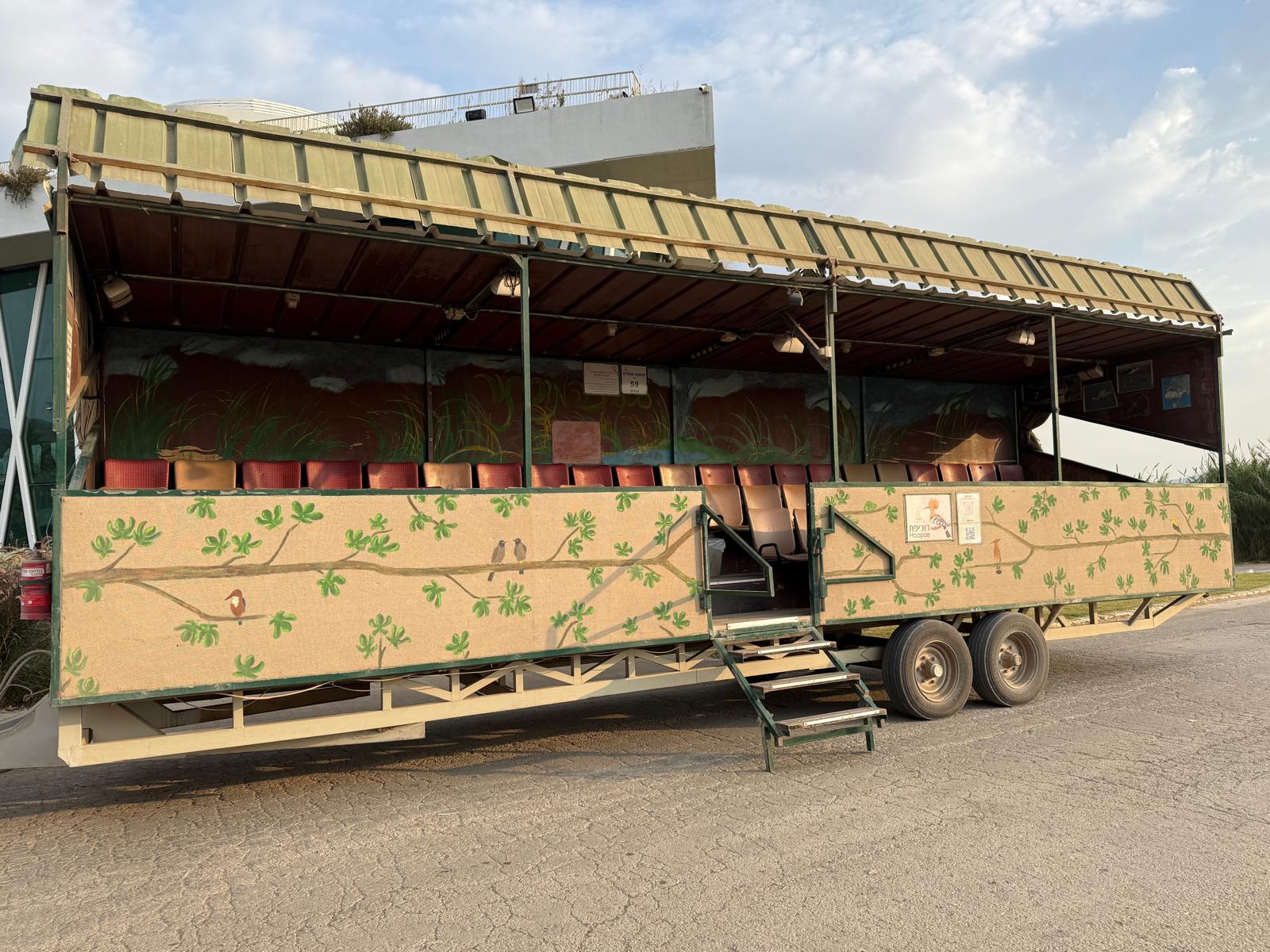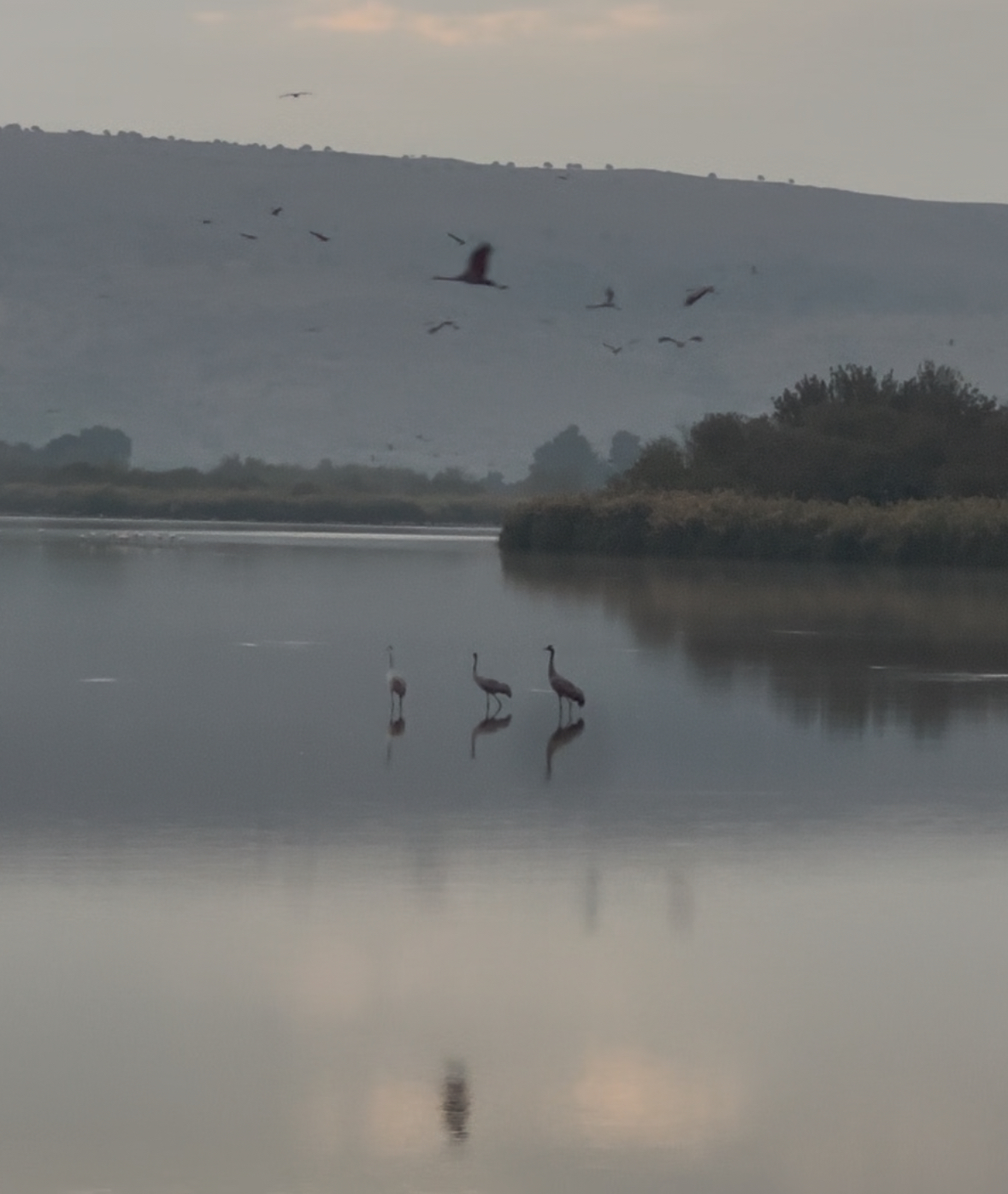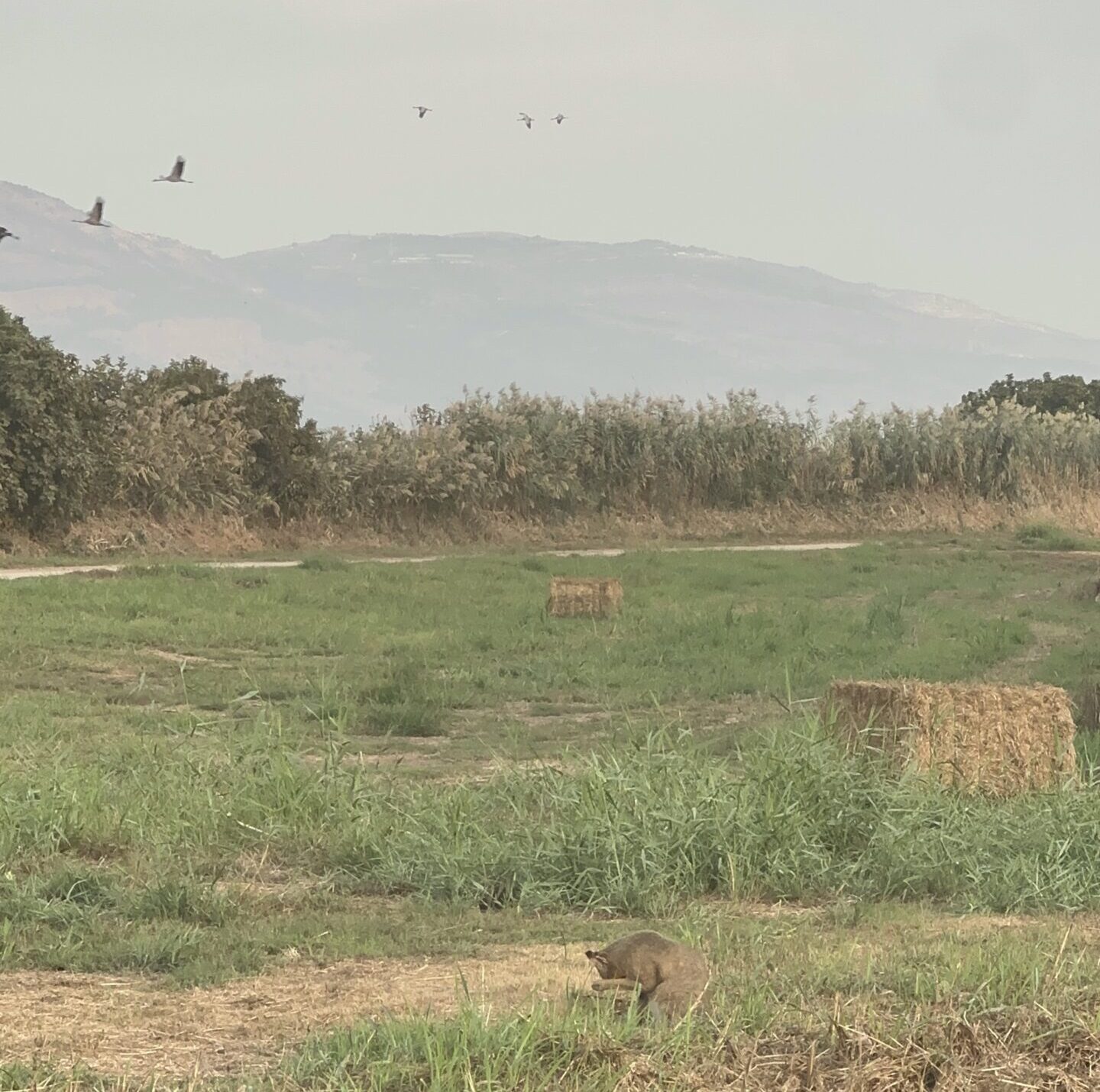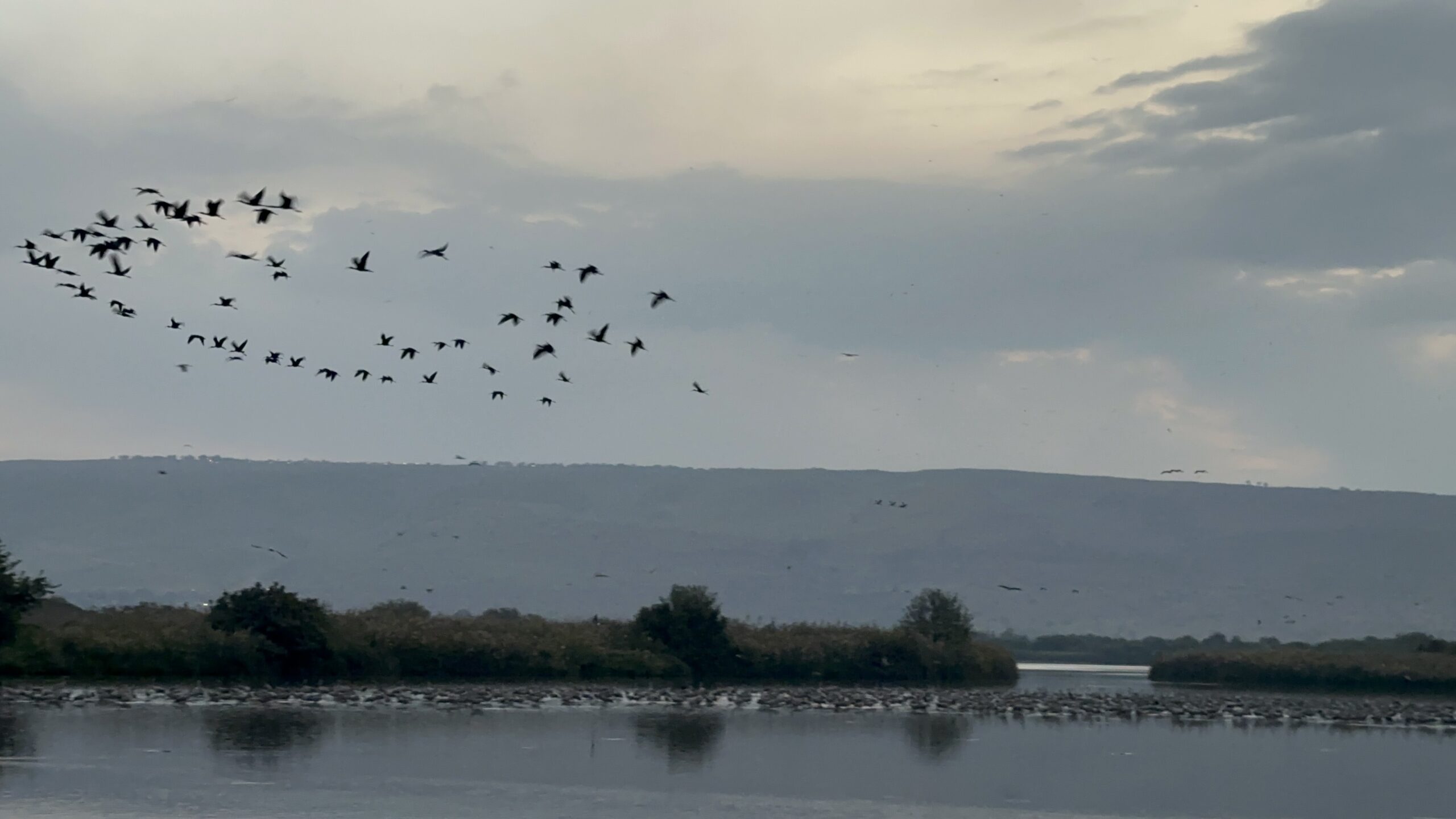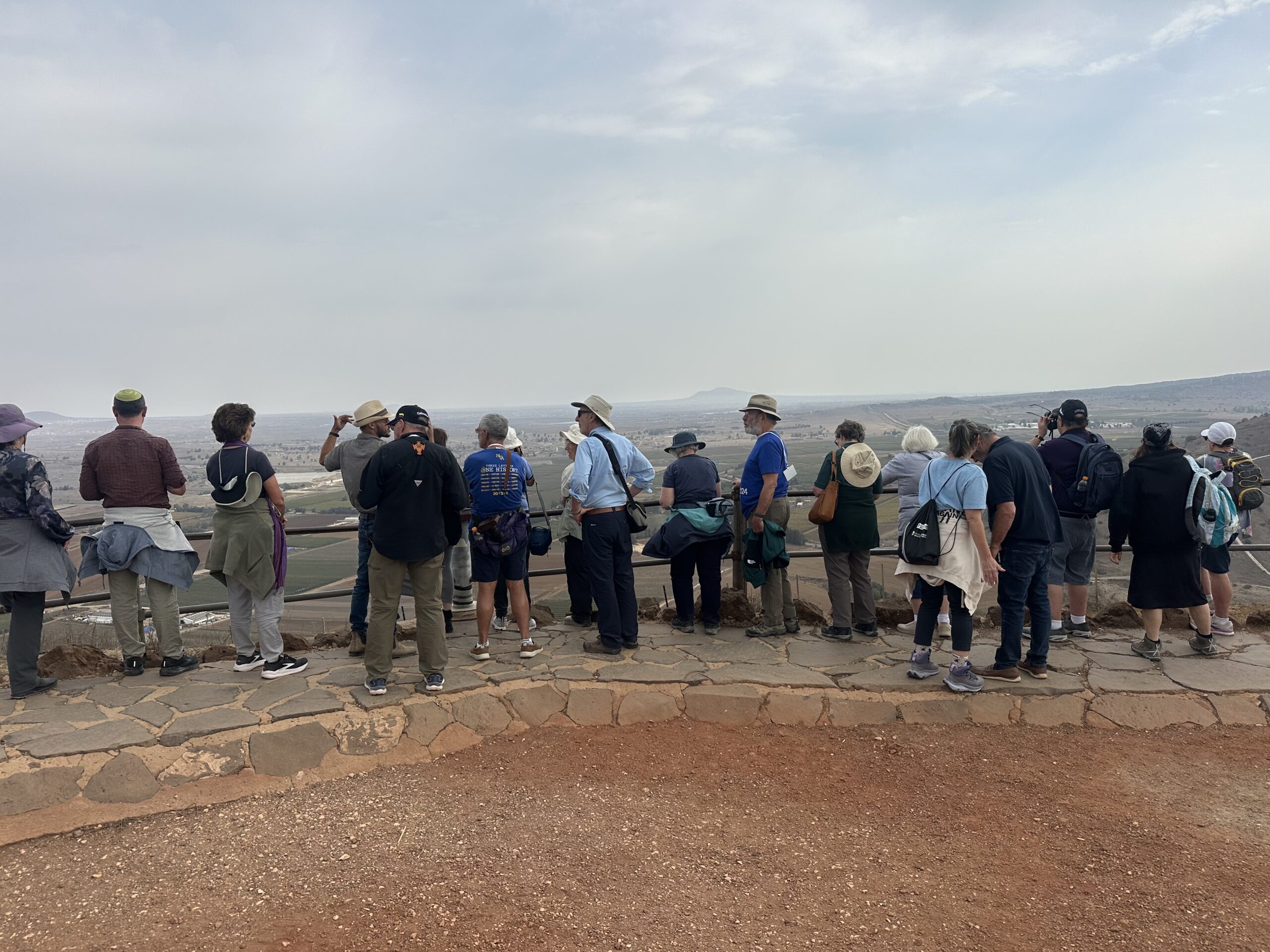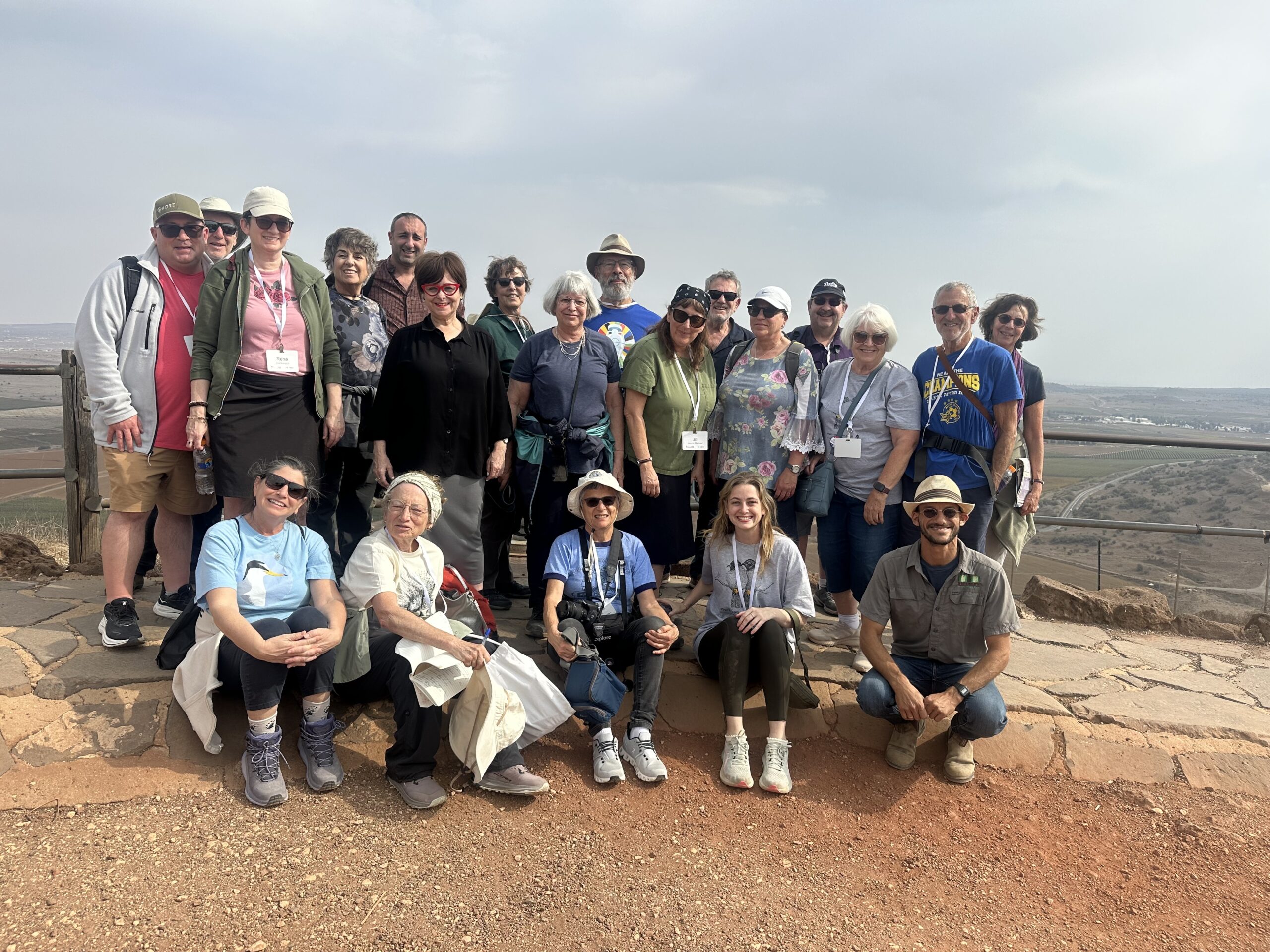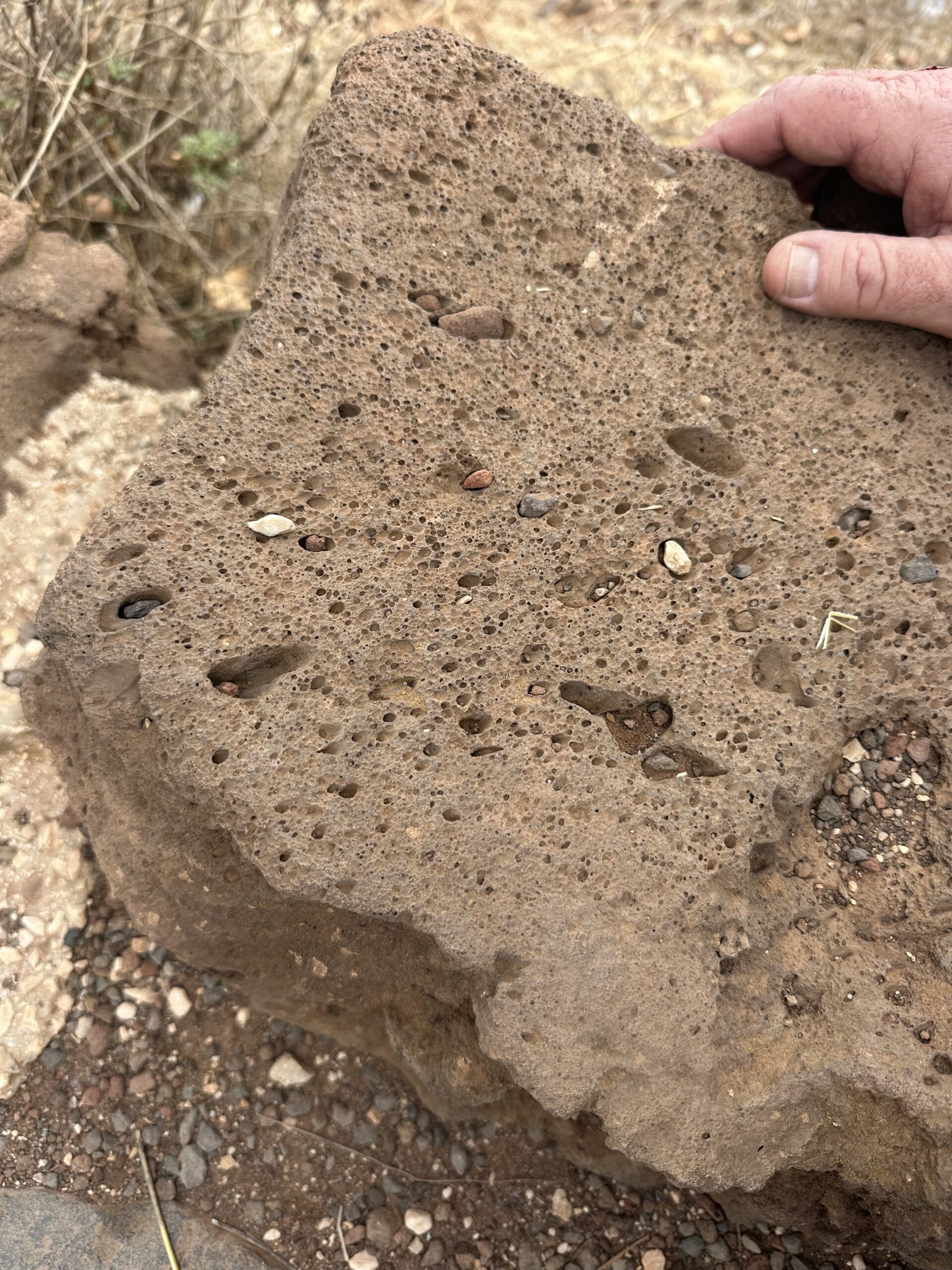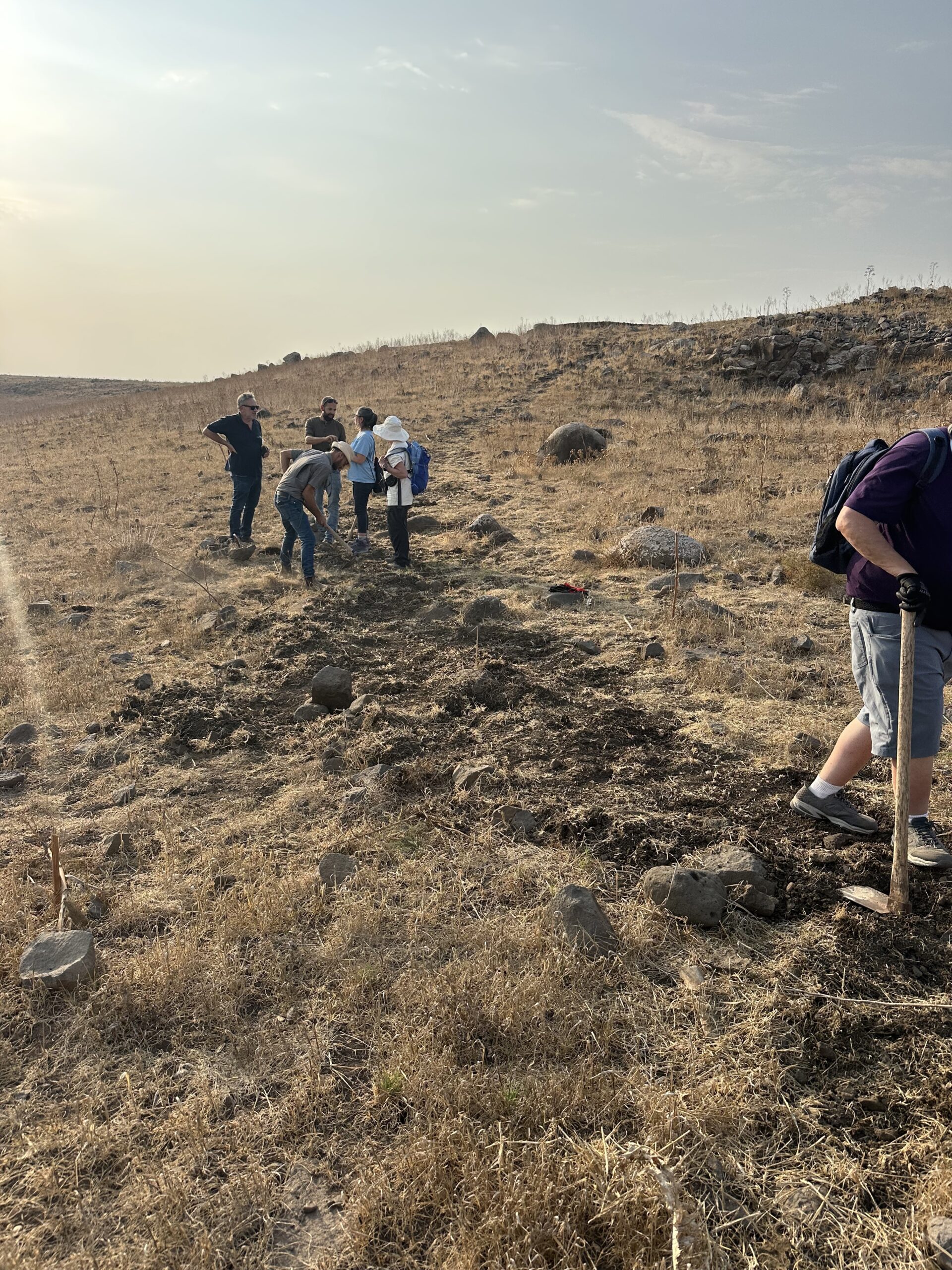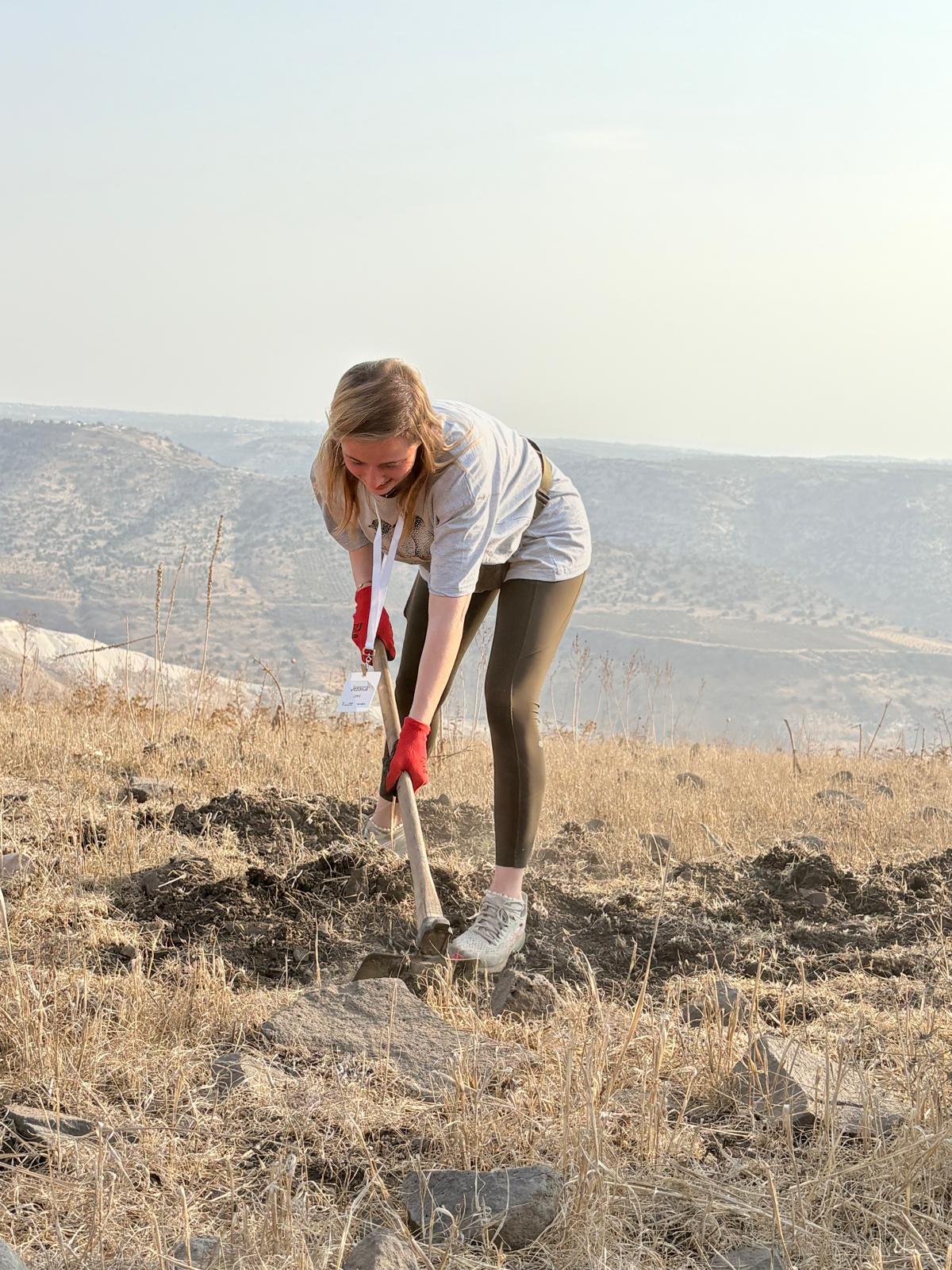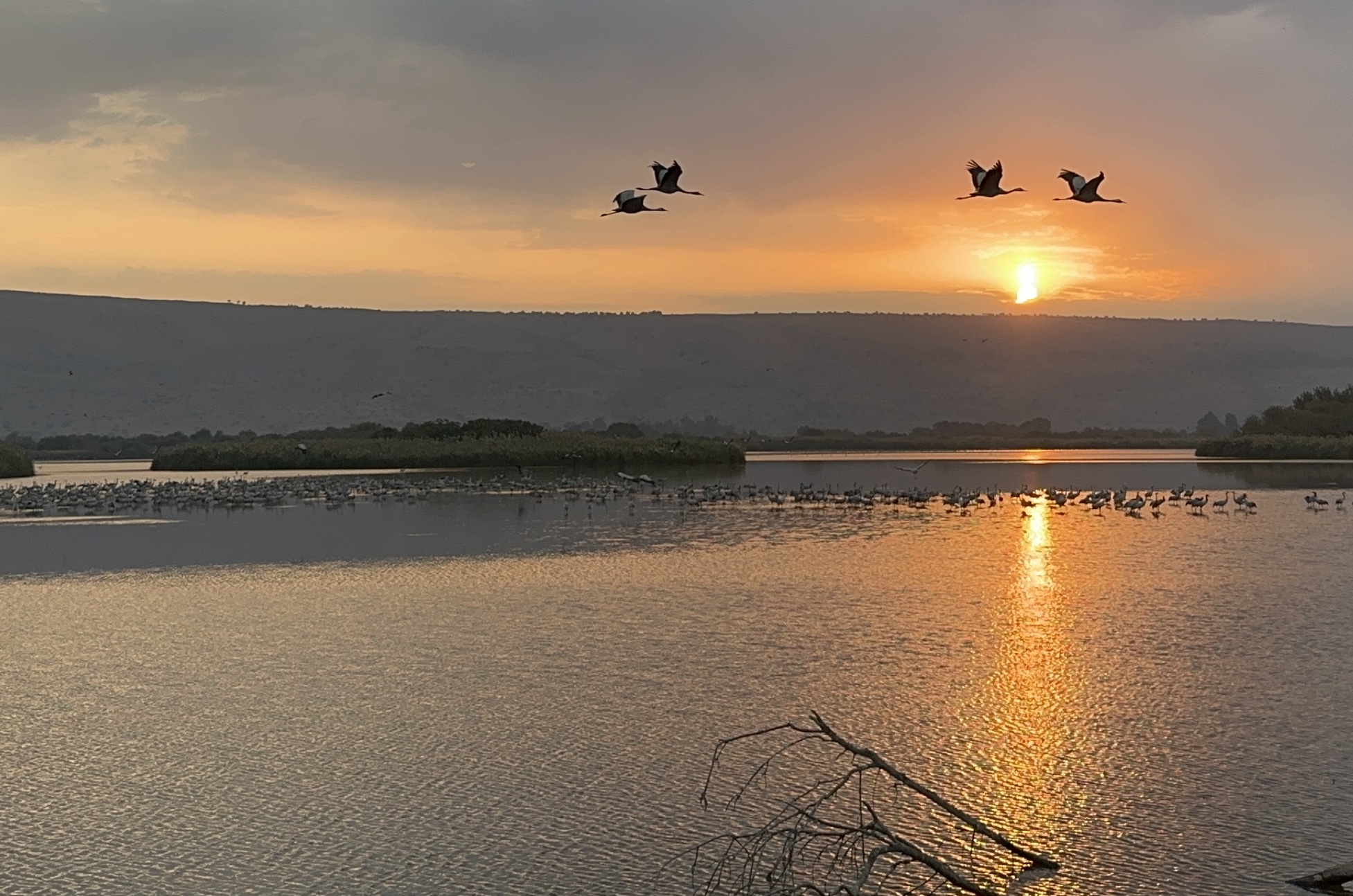
05 Nov November 4, 2025: Day 3
by Jessica Lewis, Director of Marketing and Communications at Nature Israel
Hula Valley Mobile Hide Tour
We woke at 4:00 AM and drove north in the dark toward the Hula Valley. At the mobile hide, our guide Moshe greeted us and said,
“There’s thousands of cranes just waiting for you to meet them.”
The hide itself was a long, low vehicle with open sides facing directly onto the water, carried slowly by a tractor. Painted in greens and grassy patterns to blend into the landscape, it moved along the marsh so we could watch without disturbing anything, slipping into the world of wetlands for a moment, unnoticed.
Before dawn, the cranes were already loud, adults trumpeting in full, horn-like calls, chicks answering with quick, high-pitched squeaks. Their voices layered over each other in a constant, chaotic chorus. At some point, someone flashed a bright laser light from nearby, likely a farmer attempting to scare the cranes away from his peanut fields, but the light set off a chain reaction. Suddenly, everything went quiet, and in a single whoosh of wings, thousands of cranes lifted off the wetland at once. Their abrasive honks replaced by the soft rush of millions of feathers cutting through the dark. Minutes later, the birds settled back into the marsh as the first light reached the Golan Heights. These cranes are on their way to Ethiopia and often migrate in family units; we observed a pair waiting until their chick found them again, turning two into three as they reunited. I felt like a small witness to something numinous and powerful, a cycle that has been happening long before us, and will continue long after, if we keep caring for the wetlands beneath it.
Photos by: Judy Katz, Hugh Mainzer
Among the cranes were other amazing characters of the wetlands: a spoonbill standing at the water’s edge with its wide, flat bill; a kingfisher perched like a spark of blue on a reed; some flamingos standing quietly in the shallows; and a great white egret, tall and still, its white plumage bright against the water. Then someone pointed out a swamp cat with a broken tail crouched at the edge of the reeds, eyes locked and waiting to pounce. Dan told us he’s a regular here. Soon after, we spotted a female swamp cat stepping into the pond for a morning swim. Seeing two swamp cats in one morning was rare, and a hopeful sign that the wetland is healthy enough to support them.
“Nature doesn’t speak for itself. We need to tell the story of these cranes.”
Dan explained that part of the effort here is bringing people to places like this, to witness the migration and then push policymakers to protect these landscapes. By the time we drove away, dawn had fully settled over the valley. The cranes still flew above us, families drifting south, guided by instinct, sky, and a route that has passed through Israel for longer than any of us can imagine.
Mount Ben-Tal
Our next stop was Mount Ben-Tal, an extinct volcano overlooking the Golan Heights. Wind moved through the trees as Guy Aly, SPNI staff, welcomed us and explained how the northern plateau rises higher than the south, creating a natural military advantage. From this quiet viewpoint, we began learning about an unexpected partnership between SPNI and the Israel Defense Forces.
Guy outlined three themes: the Nature Defense Force initiative, the current war, and post-war recovery.
“You may be surprised, but there are many, many opportunities for nature when you think of the army a bit differently than only the ones with the tank.”
Guy explained how Prof. Yossi Leshem, through SPNI’s Hoopoe Foundation, proposed a bold idea: that base commanders take responsibility for the environment on their land. The army controls 54% of Israel’s land for training, so even small changes have enormous impact. With support from two former generals, the initiative reached the Deputy Chief of Staff, and the IDF began to integrate environmental stewardship into its operations.
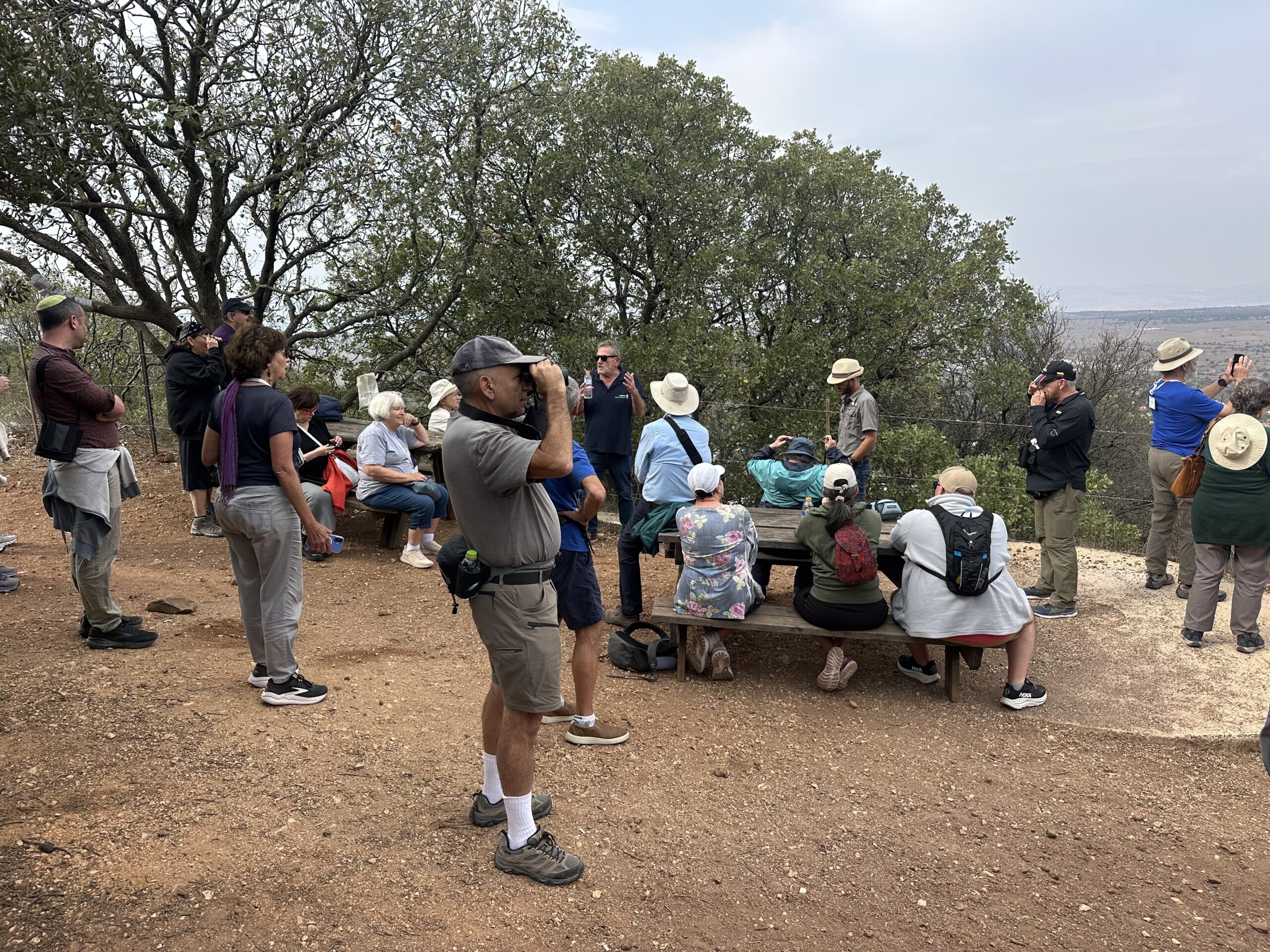
Guy told us that one early project focused on Mount Hermon. SPNI worked with the army to clean the entire mountain and implement a month-long quiet period during nesting season. SPNI funded the first stage, and after seeing results, the army continued the work and now funds half of these projects. Today, there are 65 active environmental projects across IDF units, from adopting nature-based solutions on bases to using SPNI’s wildfire response plan during the war to protect people, wildlife, and land now, and guiding long-term planning for the future. Lawrence added that even abandoned IDF bunkers now support endangered bats; SPNI works with the army to shape the ceilings so stalactite-like structures give bats places to roost.
We walked to the famous lookout where you can see into Lebanon and Syria. As we arrived, the sun slipped out and a brief sunshower passed over us, soft rain cooling our skin as we stood on the rim of an ancient volcano, looking out across borders that nature pays no mind to.
By this point, after such an early morning, I was starting to lose steam. Jay called me over and pointed to a rock with small, perfectly shaped holes scattered across its surface; next to it were tiny pebbles that fit neatly inside each space. He told me it was like a little puzzle. I crouched down and placed a few stones. It was such a simple thing, but so fun, and a reminder of how naturally SPNI staff are able to create immersive and interactive nature-based activities.
Yarmouk Fortress & Border Triangle
Our final stop of the day was the Yarmouk Fortress overlook, not a nature reserve, but the beginning stages of a lookout point perched above the meeting of three borders: Israel, Syria, and Jordan. Guy told us that this site exists because someone from the community asked the army to create a simple lookout here and plant trees. A year and a half later, after the war began, he was killed in Gaza. Now, two groups of soldiers are working here, one clearing rocks and debris, the other building a small trail up the hill so future visitors can reach the lookout safely.
“The army considers that it’s their job and responsibility to allow civilians to reach all these places in Israel safely,”
Standing there in the hot sun, watching the soldiers’ labor shape access for strangers yet to come, I kept thinking about how much of this day was about witnessing, witnessing migration, wildlife, landscapes, and how those before us made protected spaces for us to see this nature. If they hadn’t, I wouldn’t have been able to witness these places at all. So now, when I picked up a hoe to help the soldiers turn over soil and clear rocks and weeds to create this trail, it felt incredibly meaningful, taking part in a mitzvah for whoever might walk here next.
Jay shared that the IDF originally planned to place tanks here, but priorities shifted. “This is a place for the sustainable development of the land,” he said,
“We believe in making nature accessible to the public. This is a great example of that.”
SPNI works with the government, the army, and development teams, helping translate big plans into sustainable ones. Not stopping development in these cases, but guiding how it can happen responsibly.




